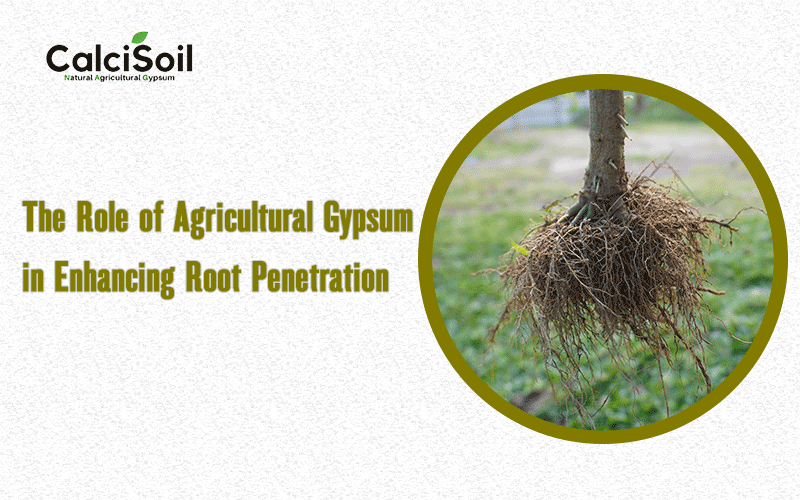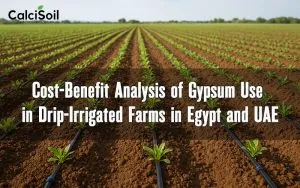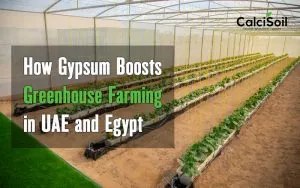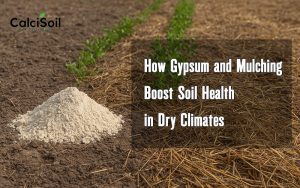
Agriculture is the backbone of global food security, and efficient crop production largely depends on healthy, robust root systems. A well-developed root system ensures that plants have access to water, nutrients, and oxygen, all essential for growth and high yields. One crucial but often overlooked factor influencing root penetration and overall soil health is agricultural gypsum. Known for its ability to improve soil structure and chemistry, gypsum (calcium sulfate dihydrate) has been a valuable tool for farmers aiming to enhance root growth and optimize crop performance.
What is Agricultural Gypsum?
Agricultural gypsum is a naturally occurring mineral composed of calcium sulfate dihydrate (CaSO₄·2H₂O). It is widely used as a soil amendment to improve soil quality, especially in regions with heavy clay soils or where subsoil hardpans are present. Gypsum differs from other soil amendments like lime (calcium carbonate), which is primarily used to adjust pH levels. While gypsum does not alter soil pH significantly, it has profound effects on soil structure and nutrient availability, making it an ideal supplement for improving root penetration.
Root Penetration and Its Importance
Root penetration refers to the ability of a plant’s roots to grow and extend into the soil. This process is critical for accessing water and nutrients that are stored deep in the ground. The better the root system, the healthier the plant is likely to be. However, poor soil conditions can limit root growth. For instance, compacted soils, high levels of sodium, and imbalances in calcium and magnesium can restrict root development, ultimately reducing crop yield.
Improving root penetration is not just about loosening the soil; it is also about creating the right chemical balance in the soil. This is where gypsum can make a significant difference.
How Gypsum Enhances Root Penetration

- Improving Soil Structure
One of the most direct effects of agricultural gypsum on root penetration is its ability to improve soil structure, particularly in clay soils. Clay soils often become compacted and sticky, hindering the ability of roots to grow through the dense layers. The calcium in gypsum works by displacing sodium in the soil, a key contributor to soil compaction. Sodium causes clay particles to disperse and stick together, forming an impermeable crust that roots cannot penetrate.
When gypsum is applied to the soil, the calcium ions replace sodium ions, which are then leached away by rainfall or irrigation. This process flocculates the clay particles, meaning they clump together to create a more porous soil structure. These larger aggregates create pathways for roots to grow, allowing for better penetration into deeper soil layers. Improved soil porosity also enhances air and water movement in the soil, providing a healthier environment for root development.
- Increasing Water Infiltration and Retention
Gypsum also promotes better water infiltration, which indirectly helps root penetration. In soils with poor structure, water tends to run off the surface rather than soak in, leaving the roots dry and depriving plants of essential moisture. Gypsum’s ability to improve soil structure allows water to infiltrate deeper into the soil profile, where roots can access it more readily. Additionally, gypsum improves the soil’s water retention capacity, reducing drought stress and encouraging deeper root systems as plants grow to access the available moisture.
- Correcting Subsoil Hardpans
Subsoil hardpans are dense, compacted layers that form below the surface, often as a result of heavy machinery use or natural soil conditions. These hardpans can severely limit root penetration, trapping roots in the upper layers of soil where they are more vulnerable to temperature fluctuations, drought, and nutrient shortages. The calcium in gypsum can help break up these hardpans, promoting root growth beyond the compacted layers and allowing roots to explore deeper soil horizons for water and nutrients.
- Reducing Aluminum Toxicity in Acidic Soils
In acidic soils, aluminum can become soluble and toxic to plants. Aluminum toxicity stunts root growth and prevents roots from penetrating deeper into the soil. Although gypsum does not directly neutralize soil acidity, the sulfate component of gypsum reacts with aluminum to form aluminum sulfate, which is less toxic to plants. By mitigating aluminum toxicity, gypsum allows roots to grow more freely in acidic soils, increasing the root zone and improving overall plant health.
- Balancing Nutrient Availability
Gypsum provides a source of both calcium and sulfur, essential nutrients for plants. Calcium plays a vital role in cell wall formation, ensuring strong and healthy root development. Sulfur is crucial for protein synthesis and enzymatic functions, contributing to overall plant vigor. By supplementing these nutrients, gypsum helps support healthy root systems, which are better able to penetrate the soil in search of water and nutrients.
Conclusion
Agricultural gypsum is a valuable tool for enhancing root penetration in a wide variety of soil types and conditions. Its ability to improve soil structure, promote water infiltration, correct subsoil hardpans, reduce aluminum toxicity, and provide essential nutrients like calcium and sulfur makes it a powerful amendment for promoting healthy, deep-rooted plants. For farmers seeking to optimize their soil conditions and improve crop yields, gypsum offers a sustainable solution to the problem of poor root penetration. By enabling better root growth, gypsum can help ensure plants access the resources they need to thrive, ultimately contributing to more resilient agricultural systems.







